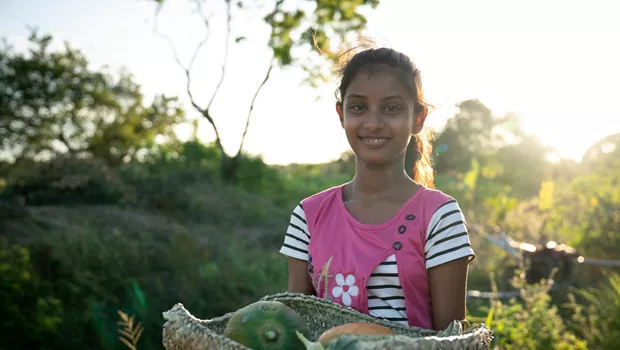Join Ms. Quyen for a lesson on climate change — and its impact on gender inequalities
May 02, 2024
Take a seat in a Room to Read classroom in Vinh Long province, Vietnam, and experience a lesson on the science of climate change — and its impact on gender inequalities — delivered to secondary school students enrolled in Room to Read's climate justice club.
Building model communities
"Hey, guys, this area is completely flooded due to the heavy rain!" a student yelled to a classmate on the far side of the schoolyard.
Students were spread across the cement, heads down, notebooks in hand, immersed in the process of building model communities — and testing their resilience to water and wind.
"To create your models," their teacher, Kim Quyen, began earlier that day in a school classroom, "you will work in groups to complete three main phases: the first is a planning phase, then building phase and final adjustments phase.
"Let’s get started with the planning phase!" Ms. Quyen continued. "Each group will spend the first 10 minutes planning what you want your community to look like. You will draw your community ideas on a flip chart — the drawing does not need to be pretty; it is just to help your group build the model community later. Make sure everyone in the group has a chance to share their ideas."
Room to Read's climate justice club in Vietnam was initiated in 2024 as part of our Girls' Education Program, and teachers report that students are eager to attend, excited for content that touches on everyday issues at school, at home and in their communities — like lessons on their carbon footprint, the effects of greenhouse gasses, the impacts of drought, flooding and hurricanes. In Vinh Long province, which is situated roughly 150 kilometers southwest of Ho Chi Minh City, communities are surrounded by water: the Mekong River on the northeast border, the Hau River on the southwest border. Both rivers empty immediately to the south and east into the East Vietnam Sea. This location makes communities particularly vulnerable to flooding and severe storms.
"In the planning phase," Ms. Quyen continued, "your group will have to decide what you want the land and water area to look like. Each group can add their own creative touches to their models, but all models should include:
- Terrain or land that is varied in height — add one or two hills for example, or a sloping area that goes down to the water;
- An area where water will go — this could be the edge of the ocean if you are the coastal community group or a river with land on both sides, a lake or pond that is completely surrounded by land if you are the inland community group.
"Your group will also decide where you will put buildings and other infrastructure that you will create to represent health centers, schools, markets, farms and grocery stories, stories and business, roads and bridges, and homes. Your plan should include buildings in different places — near the water, on higher terrain, in more sheltered areas or near bridges."
Students hurried into small groups, gathered around classroom tables and began planning their communities. One group planned a coastal community, vulnerable to sea level rise and hurricanes. Another planned a community along the banks of a river, in an area prone to flooding.

With plans developed, Ms. Quyen resumed her instruction.
"Now that the planning phase is completed," she began, "we are in the building phase. As a team you will then have 25 minutes to create the terrain and community buildings. The model buildings do not need to look exactly like a hospital, school or home, for example. They are only meant to represent them. Because there are so many items to create, you will want to agree on who makes what to use the time efficiently.
"In the last step, the final adjustments phase," she continued, "you will have just 3 minutes to place the buildings and infrastructure pieces onto the terrain and make any final adjustments."
Student gathered materials: popsicle sticks and colored pens, leaves, corrugated cardboard, plastic trees and shrubs, and dirt. They constructed homes and hospitals, markets and schools, molded hills and carved out lakes and rivers. 
Testing the impacts of climate change
"Now that we have prepared models," Ms. Quyen announced, "we will look at the impacts of climate change on these communities. Some of the common results of climate change are change in rainfall — both too little and too much — more intense storms and sea level rise."
"Let’s take a look at the models we created," she said. "Since you constructed them, we have added no water, and our model communities have sat exposed to direct sunlight, which has resulted in dry terrain. They have experienced what we know as drought, or a lack of rainfall.

"What do you notice about your community? What will happen to your community if drought conditions continue or worsen? Take 5 minutes with your group to discuss what you notice about drought on your community. Use the Room to Read 'Participant Worksheet: Observation Notes' to take notes."
"Now," Ms. Quyen continued after pausing for reflection, "we are going to see what happens when the sea level rises. Let’s stand around the coastal community model. Have a volunteer add water directly into the ocean area until at least some of the buildings along the edge of the water are flooded or start to fall into the water."

"What do you notice about this coastal community?" she asked again. "Take 5 minutes to discuss with a partner or reflect individually on what you notice about sea level rise in your model."
"Now," Ms. Quyen began again, "we are going to see what happens when it rains too much in each of the models.
- Give each group a prepared 'rainmaker' and two cups of water.
- Have a volunteer pour water through the 'rainmaker' into the community to give the effect of raining strongly.

"What do you notice about your community? Take 5 minutes with your group to discuss.
"Now, we are going to see what happens when it an intense storm — this means more rain plus wind — hits your community models.
- Give each group an additional two cups of water and 'windmakers.'
- Have a volunteer pour water through the 'rainmaker' into the community to give the effect of raining strongly while additional volunteers use the 'windmakers' to move the air around the model."





